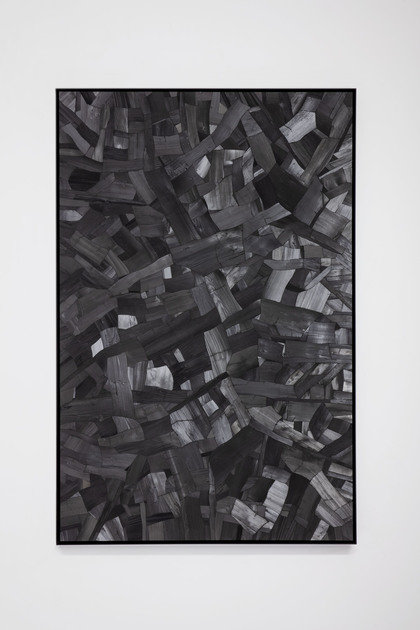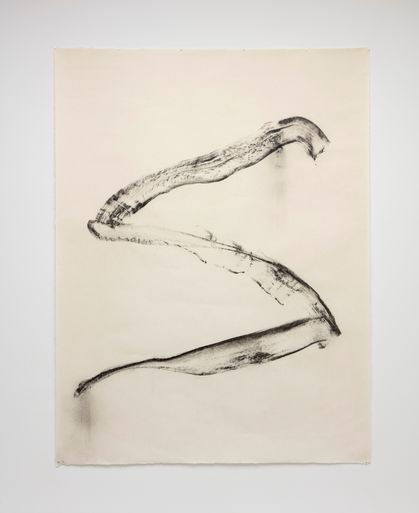-
From Current Issue
-
- Editor’s Letter Fire in the Heart
- Reviews I Gusti Ayu Kadek Murniasih
- Reviews 11th Seoul Mediacity Biennale: “One Escape at a Time”
- Dispatch Networked China
- One on One Monira Al Qadiri on Yukio Mishima
- Essays The rise of independent art spaces in pandemic-era Shanghai
- Features Tuan Andrew Nguyen
- Table of Contents
- Web Exclusives
- Archive
- Subscribe

R
E
V N
E
X
T
Installation view of LEE BAE’s “Promenade” at Perrotin, New York, 2019. Photo by Guillaume Ziccarelli. All images courtesy the artist and Perrotin, Paris / New York / Hong Kong / Seoul / Tokyo / Shanghai.
Widely exhibited in South Korea and France—his birth country and adopted homeland respectively—but lesser known elsewhere, Lee Bae’s striking abstract art is made with a single material, charcoal. From this crude, organic substance which he makes himself in the mountainous forest region of Cheongdo, Lee inventively creates sublime sculptures, works on paper, paintings, and installations. For his first solo exhibition at New York’s Perrotin, he transformed the large gallery space into a monochromatic temple. Presenting three distinct ongoing bodies of work—Issu du Feu, Landscape and Untitled (ranging from 2002–2019)—he constructed an environment of sensory engagement where his idiosyncratic uses of charcoal were installed to be observed by an ambling audience.
A sprawling installation of 24 jumbo burnt and bound tree trunks from his Issu du Feu series dominated the floor of the gallery. The floor itself was covered by the artist with white mulberry paper through a timely process of gluing sheets of hanji (Korean handmade paper) together on-site, mimicking the interiors of traditional Korean homes. In replicating this cultural convention, Lee lined the walls with two-dimensional pieces that could be confronted and contemplated upon during the walkthrough. The pine tree trunks, burned in a kiln for two weeks until they become charred all the way through and start to split from the drying of the wood, were subsequently cooled and then bound with elastic, cloth covered cording. Like firing pieces of ceramics from clumps of clay, Lee coaxes beauty out of the mundane through his intuitive selection of which chunks of wood to burn. Although laid out in the space in a grid-like pattern, the artist shifted the sculptures ever so slightly, mirroring natural pathways in a forest.
Two of his large-scale Issu du Feu paintings, made from shards of irregular shaped cut pieces of charred wood collaged together with a glue processed from tree sap, rested on the walls as dynamic mosaics. Resembling crazy quilts, Lee finely sanded the rough pieces of charcoal to organically define the surface, shifting the viewer’s eyes as Ad Reinhardt’s perceptive exploration of black on black, and Pierre Soulage’s luscious use of rich, black brushstrokes which glisten as they reflect light, do. Lee, who worked with Mono-ha artist Lee Ufan in Paris for seven years, has long admired Soulage’s quest for endless black depth.
Lee’s charcoal-surfaced Landscape paintings, in which a large, thick block of powder-compressed charcoal is adhered to a white, painted canvas and then broken by the artist to show a jagged, naturalistic edge, look more like Richard Serra’s rough oil-stick drawings in texture and Ellsworth Kelly’s shapely structures in form than they do traditional landscapes—though they could be taken for aerial views. Kelly’s abstract canvases, often geometrically divided or shaped, were the subject of a survey at the Jeu de Paume shortly after Lee moved to Paris; while Lee would have been equally exposed to Serra’s powerful works on paper which employ a thick impasto of black paint-stick. Textured with a rough sandpaper to create a coarser surface, the blackness of the charcoal in Lee’s Landscape series is completely light-absorptive, while the contrasting white of canvas is sullied with the soot of earthy matter.
A pair of large-scale works on mulberry paper from his new Untitled (all 2019) series, which beautifully captures and preserves the artist’s performative gestures, was positioned at the end of the space, pinned to the wall. The first drawing, presenting a twisting shape similar to a giant snake or the letter “S,” consists of a wide charcoal mark which the artist made by pulling a large chunk of charcoal across the paper. The second drawing flaunts a series of wide, expressive brushstrokes that have been meditatively laid out.
Making art from things that are either devolving toward or evolving from nothingness, Lee creates art for a black and white world, where materials and their usage are all that matter in the end.
Paul Laster is a New York desk editor of ArtAsiaPacific.
Lee Bae’s “Promenade” is on view at Perrotin, New York, until February 1, 2020.
To read more of ArtAsiaPacific’s articles, visit our Digital Library.





















